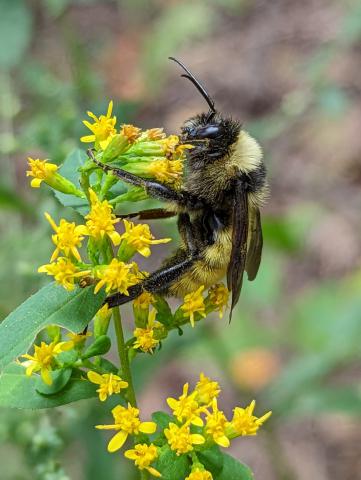 Fall is on the horizon and so are bees, hornets and wasps. As the weather becomes more enjoyable, we spend more time outdoors and increase our chances of encountering these winged insects.
Fall is on the horizon and so are bees, hornets and wasps. As the weather becomes more enjoyable, we spend more time outdoors and increase our chances of encountering these winged insects.
What is the difference between bees, hornets and wasps?
Bees, hornets and wasps are all types of flying insects, but they have some differences in terms of appearance, behavior and habitat.
Bees are known for their role in pollination and are generally less aggressive than hornets and some species of wasps. They have a more robust, hairy body and are typically black and yellow in color. Pollen and nectar are the main sources of food for bees. Examples of bees in Fairfax County are bumblebees, honey bees and carpenter bees.
Wasps are a diverse group of insects that can vary in size, color and behavior and are typically hairless. They usually have a slender body with a narrow waist and can be brightly colored. Wasps can be social or solitary. Their behavior can range from mildly aggressive to highly aggressive depending on the species.
Hornets are a type of wasp that are generally larger and more aggressive. They have a smooth body and are often black and white or black and yellow in color. Hornets can build large nests and are known for their potent sting.
Wasps and hornets are general scavengers feeding on other insects, food left lying around and decaying fruit. Examples of wasps in Fairfax County are bald-faced hornets, paper wasps and yellow jackets.
How to live with wasps and bees
While bees and wasps can be scary, it is possible to live harmoniously with these stinging creatures. We recommend practicing the following tips the next time you are outdoors.
- Keep food and beverage containers sealed after consumption. Throwing soda cans in an open trash can is inviting bees, hornets and wasps.
- Use large resealable bags at your outdoor picnic.
- At a large event, ensure trash bags are closed and sealed after every deposit.
- If you see many insects buzzing around, use caution as there may be a nest near you.
- Swatting at stinging insects can make them alarmed and cause them to sting.
- If a bee, hornet or wasp lands on you, use something to slide under the insect to remove it.
Why not spray insecticides?
Broad spectrum insecticides not only kill targeted pests, they also kill beneficial insects, including bees, butterflies and ladybugs. Bees and butterflies are important pollinators that aid food production. Birds and other animals that eat insects suffer when insect populations decline.
The aggressive yellow jacket
Yellow jackets are more aggressive during the fall. Despite their tough appearance and the ability to sting, they are beneficial. They help keep insect-pest populations, such as flies and caterpillars, in check.
The best thing you can do is to use preventive measures. Once yellow jackets have found a regular food source, they are hard to repel.
To find out more about bees and wasps in Fairfax County, here is a list of resources:

